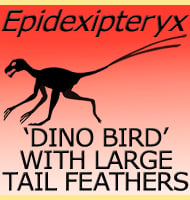Epidexipteryx
In Depth Epidexipteryx was a very special find as not only is it one of the earliest ‘dino-birds’ it also had highly ornate tail feathers. These feathers are thought to have been similar to those of a peacock, and as display feathers, possibly only present in the males for the purpose of attracting females. This … Read more
